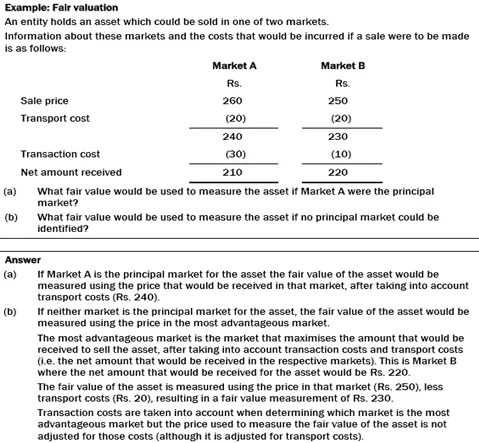Overview
IFRS 13 Fair Value Measurement – The purpose of IFRS 13 is to: define fair value, set out a single framework for measuring fair value, specify disclosures about fair value measurement. These IFRS 13 summary notes are prepared by mindmaplab team and covering, IFRS 13 revised amendment, the key definitions, full standard with illustrative examples, with IFRS 13 disclosure requirements, IFRS 13 fair value measurement, fair value hierarchy, valuation techniques, IFRS 13 highest and best use method. This is the IFRS 13 full text guide; we have also prepared IFRS 13 pdf version download.
IAS Standards
IAS 2 Inventories
IAS 7 Statements of cash flows
IAS 7 Statement of cash flows – Revisited
IAS 8 Accounting policies, changes in accounting estimates, and errors
IAS 10 Events after the reporting period
IAS 16 Property, plant and equipment
IAS 20 Accounting for government grants and disclosure of government assistance
IAS 21 The effects of changes in foreign exchange rates
IAS 24 Related party disclosures
IAS 27 Consolidated and separate financial statements
IAS 28 Investments in associates and joint ventures
IAS 32 Financial instruments: presentation
IAS 33 Earnings per share – Revisited
IAS 37 Provisions, contingent liabilities and contingent assets
IFRS Standards
IFRS 5 Non-current assets held for sale and discontinued operations
IFRS 7 Financial instruments: disclosures
IFRS 10 Consolidated financial statements
IFRS 12 Disclosure of interests in other entities
IFRS 13 Fair value measurement
IFRS 15 Revenues from contracts with customers
IAS 17 VS IFRS 16 Lease – Differences
There are many instances where particular IAS / IFRS requires or allows entities to measure or disclose the fair value of assets, liabilities or their own equity instruments.
Purpose of IFRS 13
The purpose of IFRS 13 is to:
- define fair value
- set out a single framework for measuring fair value
- specify disclosures about fair value measurement.
IFRS 13 does not change what should be fair valued nor when this should occur.
IFRS 13 does not apply to:
- share based payment transactions within the scope of IFRS 2
- Leasing transactions accounted for in accordance with IFRS 16 Leases
- measurements such as net realisable value (IAS 2 Inventories) or value in use (IAS 36 Impairment of Assets) which have some similarities to fair value but are not fair value.
The IFRS 13 disclosure requirements do not apply to the following:
- plan assets measured at fair value (IAS 19: Employee benefits)
- retirement benefit plan investments measured at fair value (IAS 26: Accounting and reporting by retirement benefit plans); and
- assets for which recoverable amount is fair value less costs of disposal in accordance with IAS 36.
IFRS 13 Definition
- Fair value – Fair value is the price that would be received to sell an asset or paid to transfer a liability in an orderly transaction between market participants at the measurement date (i.e. it is an exit price).
Note that the fair value is an exit price, i.e. the price at which an asset would be sold.
- Exit price – The price that would be received to sell an asset or paid to transfer a liability.
- Entry price – The price paid to acquire an asset or received to assume a liability in an exchange transaction.
- Unit of account – The level at which an asset or a liability is aggregated or disaggregated in an IFRS for recognition purposes.
- Most advantageous market – The market that maximises the amount that would be received to sell the asset or minimises the amount that would be paid to transfer the liability, after taking into account transaction costs and transport costs.
- Principal market – The market with the greatest (highest) volume and level of activity for the asset or liability.
- Highest and best use – The use of a non-financial asset by market participants that would maximise the value of the asset or the group of assets and liabilities (e.g. a business) within which the asset would be used.
- Inputs – The assumptions that market participants would use when pricing the asset or liability, including assumptions about risk, such as the following:
- the risk inherent in a particular valuation technique used to measure fair value (such as a pricing model); and
- the risk inherent in the inputs to the valuation technique.
Measuring Fair value
Fair value measurement assumes that the asset (liability) is exchanged in an orderly transaction between market participants to sell the asset (transfer the liability) at the measurement date under current market conditions.
If an active market exists then it will provide information that can be used for fair value measurement.
If there is no such active market (e.g. for the sale of an unquoted business or surplus machinery) then a valuation technique would be necessary.
Principal or most advantageous market
- Fair value measurement is based on a possible transaction to sell the asset or transfer the liability in the principal market for the asset or liability.
- If there is no principal market fair vale measurement is based on the price available in the most advantageous market for the asset or liability.
- Unless there is evidence to the contrary, principal market (or failing that, the most advantageous market) is the one in which an entity normally enters into transactions sell the asset or to transfer the liability being fair valued.
- If there is a principal market for the asset or liability, the fair value measurement must use the price in that market even if a price in a different market is potentially more advantageous at the measurement date.
- The price in a principle market might either be directly observable or estimated using a valuation technique.
Transaction costs and Transport costs
- The price in the principal (or most advantageous) market used to measure the fair value of the asset (liability) is not adjusted for transaction costs.
- The price in the principal (or most advantageous) market is adjusted for the costs that would be incurred to transport the asset from its current location to that market.

Fair value of non-financial assets – highest and best use
Fair value measurement of a non-financial asset must value the asset at its highest and best use.
*The current use of land is presumed to be its highest and best use unless market or other factors suggest a different use.
Valuation Techniques
An entity must use a valuation technique that is appropriate in the circumstances and for which sufficient data is available to measure fair value, maximising the use of relevant observable inputs and minimising the use of unobservable inputs.
Quoted price in an active market provides the most reliable evidence of fair value and must be used to measure fair value whenever available.
Fair value hierarchy
IFRS 13 establishes a fair value hierarchy to categorise inputs to valuation techniques into three levels.
Level 1 – Quoted prices in active markets for identical assets or liabilities that the entity can access at the measurement date (e.g. Share price quoted on the Stock Exchange).
Level 2 – Inputs other than quoted prices included within Level 1 that are observable for the asset or liability, either directly or indirectly (e.g. Quoted price of a similar asset to the one being valued).
Level 3 – Unobservable inputs for the asset or liability. (e.g. Cash flow projections).
LIABILITIES AND AN ENTITY’S OWN EQUITY INSTRUMENTS
General principles
The fair valuation of an entity’s own equity instrument assumes that market participant to whom the instrument could be transferred would take on the rights and responsibilities associated with the instrument.
The same guidance that applies to the fair value of assets also applies to the fair value of liabilities and an entity’s own equity instruments including that:
- an entity must maximise the use of relevant observable inputs and minimise the use of unobservable inputs; and
- quoted price in an active market must be used to measure fair value whenever available.
In the absence of an active market there might be an observable market for items held by other parties as assets.
IFRS 13 Disclosure
The fair value measurement of assets and liabilities might be recurring or non-recurring.
- Recurring fair value measurements are those that are required or permitted in the statement of financial position at the end of each reporting period (e.g. the fair value of investment property when the IAS 40 fair value model is used);
- Non-recurring fair value measurements are those that are required or permitted in the statement of financial position in particular circumstances (e.g. when an entity measures an asset held for sale at fair value less costs to sell in accordance with IFRS 5).
Disclosures are necessary in respect of each of the above.
Information must be disclosed to help users assess both of the following:
- the valuation techniques and inputs used to measure the fair value assets and liabilities on a recurring or non-recurring basis;
- the effect on profit or loss or other comprehensive income for the period of recurring fair value measurements using significant unobservable inputs (Level 3).
